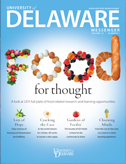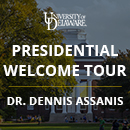
Gardens of Feedin'
OUR FACULTY | In life, we learn that hope can exist in something as small as a seed.
We see a garden, or pass a farm, and marvel that a world’s sustenance can rise from plain soil, touched only by sun and rain—and sheer hard work and human will. Anyone who has farmed or gardened knows this to be true: That only through labor and dedication, balanced with nature’s way, do we reap the benefits of the bounty.
At UD, those places of hope and will, those gardens of life-giving goodness, thrive in many areas, in many ways. Some are living gardens, full of corn and cantaloupe and greens, providing tons of food each year for the neediest Delawareans. Others serve as gardens in a broader sense of learning, like the many fields of research here that focus on ensuring access to healthful, safe and affordable food. And some are gardens of giving—sustained by hundreds of philanthropic students who raise funds for hunger relief.
In all of these gardens that the people of UD lovingly tend, the goal is simple—and closely bound to broader goals embraced for so long on this campus—to help solve the problems of a growing world, and to open pathways for inspired students and professors to be the agents of that change.
Only then can the bounty of any garden truly fulfill the seed’s true promise: to benefit not just the farmer or even the family, but also the community that gives those gardens their home. Here’s a look at some of those gardens—the Gardens of UD.
By Eric Ruth, AS93
Connecting farms to families
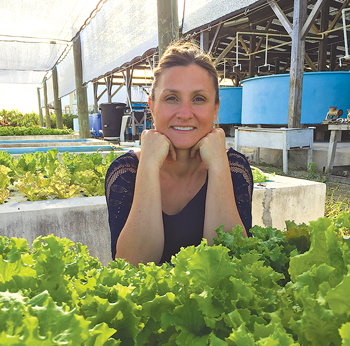
In the many areas across the country where poverty reigns, a garden-grown tomato can be a precious thing.
Some children have never seen one, and some families couldn’t imagine buying one, simply because fresh produce is rare where they live. So they eat what’s available—fast food, processed meals—and suffer soaring rates of obesity, diabetes and other preventable diseases.
The solution, says UD Prof. Allison Karpyn, is entirely within reach if society has the will to seize it. She and like-minded allies in government and the private sector have been working to spark the dynamics of a new movement, one that will inspire and incentivize better food-buying options and even bring supermarkets and desperately needed jobs to these neighborhoods.
“For me, it’s an equity issue. There are just certain basic needs that, if we’re going to grow our nation, we’re going to have to meet,” says Karpyn, associate director of UD’s Center for Research in Education and Social Policy and author of several major reports on strategies to resolve the issue in Delaware and nationally. “The ZIP code where you live shouldn’t determine what you can shop for. Unfortunately, that is the case in many parts of the country.”
The USDA has identified predominantly low-income areas throughout the country where it’s difficult to buy affordable or high-quality fresh food. In these urban and rural “food deserts,” as they are known, even when healthy options are within reach, they are often of such poor quality and so expensive that families tend to choose cheaper, less-healthful alternatives. It’s clear to Karpyn that they don’t necessarily want it to be that way.
“Everyone wants access to healthy food and they want their kids to grow up healthy, so it becomes a matter of making those resources available and affordable,” she says. One strategy is a program that allows people on government assistance to use vouchers to spend $2 for every $1 they have if they spend it on produce. Another lets them use their food-assistance cards at farmers markets. It is a local solution with the potential for broader scalability.
“We get emails from people telling us how much this means to them and how it has improved their diabetes, and how valuable these resources are for them and their families,” says Karpyn.
Karpyn and her team are also working with Delaware’s ShopRite supermarkets to see whether people can be encouraged to make healthy purchases simply by placing those foods more prominently in displays. “They sort of unintentionally notice it and pick it up. It plays into another theory of what we do, called behavioral economics.”
As UD puts renewed emphasis on research that will have positive impact on real-world challenges, Karpyn sees her research as a “sweet spot,” delivering solutions with direct impact not only to consumers, but farmers and communities as well.
“I do really believe that the University is committed to expanding its work in wellness promotion. I am studying how we stay well, not just what makes us sick,” she says. “With this research, we’re talking about growing food, feeding people and creating wellness for people and communities alike. It goes across the spectrum.”
Helping Communities Feed Themselves
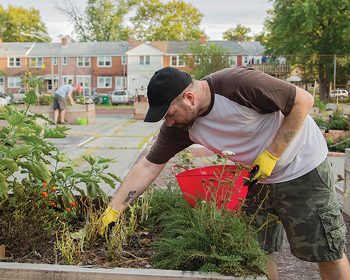
For most people, fresh produce is something that’s grown in some faraway place, shipped across oceans and continents, and eaten long after it has been picked.
Carrie Murphy and her army of volunteers want to change all that. And they’re doing it one garden at a time.
As the head of lawn and garden community education programs for UD Cooperative Extension, Murphy’s mission is to help more people grow their own food in a world where nutritious, farm-fresh produce can be an elusive and expensive commodity.
Rolling up their sleeves in schools and communities statewide, Extension’s 300-odd Master Gardener volunteers help test soil, build garden beds, design planting schedules and plan the never-ending duties of maintenance. At other times, Extension educators work hand-in-hand with fledgling farmers hoping to start small-scale commercial farms. Impact is magnified by an array of Extension partners in those communities, ranging from the Delaware Urban Farm and Food Coalition to the Wilmington Healthy Corner Stores Network.
It’s the kind of grassroots guidance that has put Cooperative Extension at the forefront of a movement for more healthful, sustainable and locally oriented food in Delaware. “Over the last 10 years, it’s been explosive,” says Murphy, ANR06. “There have been so many people interested in producing their own food.”
In 2016, Extension conducted workshops and presentations for nearly 400 people, and supported more than 20 community and school gardens in New Castle County, Delaware. Some projects oriented toward poorer inner-city neighborhoods have not only helped feed needy families, but in one case a garden planted on a vacant lot helped eliminate the spot’s drug activity.
“Community gardens are about the people,” says Sue Barton, associate professor of plant and soil sciences and an Extension specialist. “To me, a community garden is more about the camaraderie, building a sense of community, and empowering people to grow their own food.”
Growing a sense of belonging
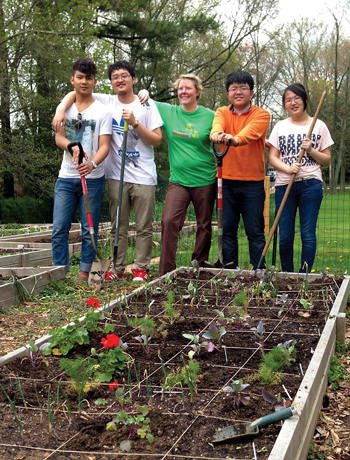
Inside the snug borders of the English Language Institute’s (ELI) Community Garden on West Main Street, the rows of vegetables have become a place for nurturing the language skills of hundreds of international students who come to UD each year. As the plants grow, students from Turkey and China and around the globe work the garden with the help of native English speakers, allowing them to share their experiences while absorbing crucial insights into a new culture and key tools for academic success.
“Research shows that language skills aren’t the only predictors of success,” says Kate Copeland, an instructor at ELI who oversees the 7-year-old garden. “They also need to be engaged and acclimated to the community. They need to have some social skills for navigating the UD campus and being part of the community, which is a challenge for any international student who doesn’t know the culture.”
To help with that understanding—and make them feel engaged with that community—the students deliver their harvest to the Food Bank of Delaware, giving them an immediate appreciation of their potential for making a difference in this new land. And, they even occasionally use the garden to get a taste of home.
“We’ve had some students grow some very interesting things,” Copeland says. “Sometimes food is the best cure for homesickness.”
A garden for the community
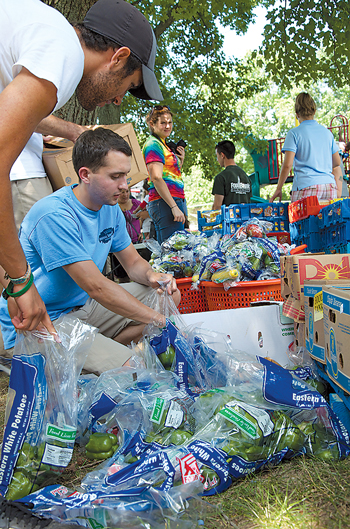
Not far from the bustling pathways of central campus, in fields where the scent of turned soil sweetens the breeze, Mike Popovich’s babies are looking good enough to eat.
His fat cucumbers bask succulently as summer arrives, the leaves of kale so perky and cheery they seem to wave hello. Soon, plump tomatoes and sweet corn will ripen, but the garlic and peppers are impatient for harvest now, hinting already at their destiny in some irresistible meal.
All around him in UD’s Fresh to You Garden, life exults in artful tangles of green, gold and red. Each day, in a year-round frenzy of planting and pruning, weeding and watering, farm manager Popovich, ANR09, and his student helpers nurture a near-continuous harvest, scrambling to satisfy demand from hundreds of drive-up customers, along with scores of Delawareans in need of a nutritious meal.
This garden is not the only way UD works to feed the community. But it’s certainly the most visible, and most direct.
No one knows that better than the Food Bank of Delaware, which has received 80,066 pounds of food over the past five years from various UD-based food drives and initiatives, including the Fresh to You Garden. “We are working to increase access to fresh produce in this area, especially for the needy,” says Popovich, crumbling a clod of the rich brown soil between his fingers with clear adoration. “This is superb soil. See how it’s friable, how it crumbles? That’s perfect loam.”
As a result of that soil, the garden is revered for its delicacies, inspiring frantic demand from high-end local restaurants such as the House of William & Merry, Capers & Lemons and Goat Kitchen and Bar. Between the 15 restaurant buyers and farm-stand sales, the garden pulls in $12,000-$13,000 in annual revenue. “We’re hoping to double that next year,” Popovich says. “I’ve seen these restaurant owners get teary talking about heirloom tomatoes.”
For student intern Maddie Hannah, AS18, the garden is not only a place where she can learn the complexities of agriculture, it’s a crucial platform for encouraging sustainable practices and “buy local” economics in Delaware. “Many people don’t think about how their food is grown,” she said. “But here, you’re not sending trucks of produce across the country. And it’s good to support small farms.”
Blue Hens help feed the world
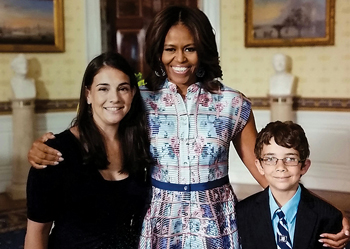
While it’s near impossible to quantify the full scope of the University’s myriad programs, food philanthropy is undoubtedly a cause that unites Blue Hens. Sometimes, though, all it takes is an army of two.
Take young Braeden Mannering, whose mom Christy, EHD15, is a communications specialist for the College of Agriculture and Natural Resources. Since 2013, 13-year-old Braeden and his mom have run a now-nationally recognized nonprofit—Brae’s Brown Bags—that has supplied 9,070 “brown bag” meals to homeless and low-income Americans (and inspired schoolchildren nationwide to do the same).
The young Mannering has served as a guest lecturer in undergraduate courses and often speaks to the Delaware Collegiate 4-H group. He participates in UD’s Day of Service and is a sponsor of the University’s annual Ag Day.
For his efforts to reduce hunger, Braeden has become a bona fide food philanthropy celebrity, attending a State of the Union Address with Michelle Obama, appearing on the Rachael Ray Show and the Today Show, and speaking before hundreds of people.
“He has taught me as much as I teach him,” says mom. “I was ignorant to the seriousness of food insecurity in Delaware and around the country. But you’d be pretty surprised what you can do when your little kid looks up to you and says, ‘Hey, why can’t we help?’”
Ways to reduce the food you throw out (and what to do if it really is past its prime)
You know the feeling. You’re doing the right thing, stocking up on fresh produce, fueling your body with only the best and most nutritious items in the store. Or so you planned. Days go by as the threat of rotted veggies looms ominously over your crisper drawer. What to do?
Here, Sharon Collison, ANR89, 94M, a clinical instructor in the Department of Behavioral Health and Nutrition, shares tips on how to save (and even resurrect) produce and other perishable groceries:
Keeping produce fresh
• Always rinse fresh greens such as Romaine lettuce and drain in a colander. Then wrap in paper towels before putting it back in the plastic bag and returning to the refrigerator drawer.
• Put the stems of fresh herbs such as parsley and cilantro in a cup of water. You can keep it in the fridge or just on the kitchen counter.
• Always leave fresh tomatoes out of the refrigerator and away from sunlight. Keep them in a separate bowl than other produce to keep them from ripening too quickly.
• Place fresh grapes in a colander and rinse well. Line a glass bowl with paper towels. Cut up into bunches, put them in the bowl and keep in the refrigerator.
• Store an apple with your potatoes to keep them from sprouting, and then store in a cool dry place in your kitchen.
• Dip cut apples and avocados in a mixture of water and lemon juice to keep them from turning brown. Then cover with plastic wrap and refrigerate.
• To keep bananas from ripening too fast, wrap plastic wrap around the crown of the bunch. (Quick tip: If you want your fruit to ripen sooner, put it in a paper bag with some bananas. The ethylene gas produced by the bananas will help get them ready sooner.)
• Keep fresh berries dry and refrigerated. Check them often so you can remove any berries that are starting to show mold and prevent them from ruining the rest.
Ways to use produce before it goes bad
• If you have vegetables that are nearing the end of their fresh life, chop them up and freeze in sandwich bags for soups or stews. Greens can be used in soups, quiches and frittatas. Onions and peppers can be easily chopped and frozen. Freeze cherry tomatoes whole.
• Some wilted veggies can be “revived.” Soak wilted celery, carrots, kale and chard in cold water. Use tomatoes that are soft but not rotten in sauces, roast them in the oven with onions and herbs for a side dish, or puree them to make a roasted tomato soup.
• Make vegetable stock from vegetables nearing the end of their fresh life. Chop mushrooms, parsley, celery, carrots, parsnips, garlic, broccoli stems and onions. Then sauté in olive oil in a stockpot, cover with cold water and simmer for 1 to 1 1/2 hours. Strain and add salt and pepper to taste. (Roasting the vegetables first can result in a fantastic flavorful stock.)
• Make juice. Before it wilts or spoils, throw produce such as carrots, broccoli, celery, greens and tomatoes in the blender and make a juice. You can also freeze the juice and defrost as needed to drink or make soup.
• Donate extra food to your local food shelter or give to a neighbor or friend.
Try this easy pasta dish.
If you have extra greens in need of a meal, Collison recommends this easy pasta dish.
Pasta with Pesto
¾ cup jarred pesto
1 box (14.5 oz) thin spaghetti
1 ripe avocado, halved, peeled and seeded
5 cups assorted baby greens (spinach, kale, arugula)
Shaved Parmesan cheese (optional)
Fresh basil leaves (optional)
In the bowl of a food processor add the pesto and avocado; mix to combine; set aside.
In a large pot bring 4 to 6 quarts of water to a rolling boil; add salt to taste and then the pasta; stir gently.
Cook pasta according to package directions; remove from heat and drain well, reserving ½ cup cooking water.
Return pasta to pot; stir in the baby greens and pesto mixture; add pasta water as needed to reach desired consistency.
Serve topped with fresh basil leaves and Parmesan, if desired.
